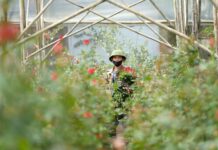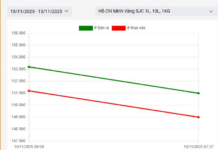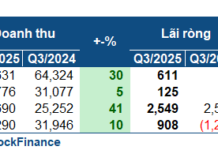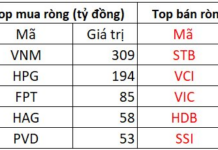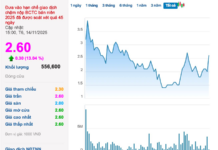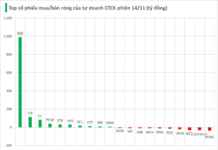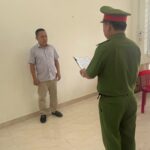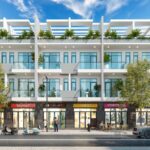The Investor Meeting program offers a panoramic view of the market, with a special focus on the banking sector. It helps investors understand the business performance and strategic orientation of Nam A Bank in the upcoming period.
At this event, Nam A Bank representatives answered many important questions from investors. These included inquiries about business results, growth prospects, and credit growth orientation; risk management strategy; the “Green – Digital Bank” strategy; the development of the 365+ ONEBANK by Nam A Bank automated transaction office network; the bank’s positioning and development orientation for the next 3-5 years, and more.
**MANY STABLE GROWTH INDICATORS**
NAB has achieved growth in many core business activities in 2024.
As of August 2024, NAB’s cumulative pre-tax profit reached over 75% of the plan assigned by the Board of Directors for 2024. The ROE ratio currently stands at 21.46%, and ROA is 1.65%, indicating that the bank has achieved high profitability in addition to its growth in scale.
NAB’s NIM ratio has improved to 3.8% (compared to 3.6% at the end of the second quarter). The bank expects the NIM ratio to remain between 3.5-3.8% from now until the end of 2024, as interest rates remain low to support individuals and businesses in the context of a challenging economy.
Operating expenses (CIR) are currently at an optimal level of around 38%. According to NAB representatives, the bank aims to be among the top 7-10 banks in Vietnam in terms of salary and welfare to attract talent, along with expanding its network of branches and ONEBANK transaction offices nationwide. NAB continues to invest significantly in technology to increase the technology component in its products and services. Therefore, CIR is targeted at 40-45% during this phase to create a foundation for the bank’s continued growth in the coming years.
In terms of risk management, NAB’s NPL ratio has remained stable since the end of the second quarter of 2024. The bank’s leadership has stated that they aim to reduce this ratio to 2% and may increase provisions by VND 300-500 billion to raise the LLCR ratio to 55-60%.

NAB’s loan portfolio has undergone a strategic shift, focusing on priority sectors such as agriculture, forestry, and fisheries (accounting for nearly 6% of the total portfolio at the end of the second quarter of 2024) and smart transportation conversion lending.
In the long term, the bank follows an industry value chain model and aims to expand this model to strategic sectors, including agriculture, forestry, fisheries, education, healthcare, and resorts. For example, in the tea industry, the bank will be involved in every stage, from seedlings and farmers to purchasing enterprises, processing, sales, and exports.
**ORIENTATION TOWARDS BECOMING A LEADING “GREEN AND DIGITAL” BANK**
NAB has affirmed its pioneering role in the field of bank digitization and greening with the launch and development of the ONEBANK digital financial ecosystem.
Since its implementation, ONEBANK has achieved remarkable growth, with a quarterly growth rate of over 40%, attracting more than 143,000 new customers as of September 2024. With nearly 1.7 million transactions, ONEBANK has made a significant contribution to NAB’s development in the digital banking sector.
ONEBANK has helped NAB expand its customer base and effectively mobilize capital. Capital mobilization from ONEBANK accounts for nearly VND 10,000 billion (6% of the total mobilization). With plans to aggressively expand its network, NAB expects to increase the number of ONEBANK transaction offices to 130 by the end of 2024, providing convenient and modern digital financial services to individual and corporate customers nationwide.
In addition, NAB continues to lead in green credit. The bank has implemented a green credit value chain focusing on agriculture, fisheries, and renewable energy. The bank aims to increase the proportion of green credit to 20-25% (2-3 times the current proportion).
The value chain in the fisheries sector is a typical example of the success of this strategy. It includes activities from breeding, farming, processing, to exports, all of which are carried out according to international green standards. This not only contributes to environmental protection but also creates long-term economic value for NAB and its customers.
**ENHANCING MARKET POSITION AND ATTRACTING STRATEGIC INVESTORS**
NAB continues to expand and enhance its position in the financial market, aiming to attract more international strategic investors. Notably, NAB’s foreign room remains relatively low, providing ample room for strategic capital sales transactions. This will not only help NAB attract more capital to strengthen its financial strength but also expand its international cooperation network, thereby enhancing its competitiveness in the global market.
With a comprehensive “green and digital” strategy, Nam A Bank is gradually expanding its international presence. The bank is not only oriented towards profit growth but also continues to affirm its potential for sustainable development, attracting strategic investors, and creating value for shareholders.
Regular investor meetings are one of the essential activities to provide objective and comprehensive information to customers. In the future, NAB will continue to implement various initiatives to promote connectivity and provide quick and transparent information to ensure the benefits of domestic and foreign investors.
The Green Production Premium: Overcoming Obstacles to Capitalize on International Demand.
The financial requirements for emission reduction measures across sectors as committed by Vietnam by 2030 amount to approximately 68.75 billion USD. This includes an estimated 24.722 billion USD (36%) from domestic sources and 44.028 billion USD (64%) in expected international support. However, there are still some challenges in capital mobilization.



